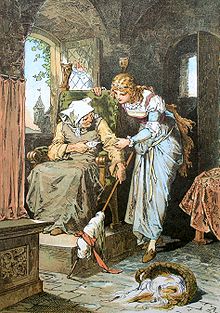Anderson lists several examples of ancient plots that bear similarities to traditional fairy tales, but I have to admit some of them seemed like a stretch to me. And this brings up an issue of how we classify fairy tale variants, verses stories with similarities. Each story contains multiple functions, or plot elements, but also usually contains visual elements or classic lines we associate-"all the better to eat you with" immediately brings Little Red Riding Hood to anyone's mind, and a glass slipper is enough to remind anyone of Cinderella. Yet virtually none of these functions or symbols is necessary to classify a story as a tale type-there are versions of Cinderella where she is identified by another means, yet the plot is enough so keep it a Cinderella tale. Yet the more the plot and/or symbols become changed, the harder it is to actually classify it as a version of the tale. Some similarities may be intentional, and some may not.
I think if I wanted to classify an ancient story as a fairy tale variant (or really, the fairy tale would be a variant of the ancient story), I'd have to see a transitional tale. The process from Cupid and Psyche to Animal Bridegroom tales to Beauty and the Beast is a good example of this, but I'm not so sure as Anderson is that any ancient story where a child is disgorged from the belly of a monster is clearly a Little Red Riding Hood story, and I don't think I'd have ever made the connection between the Exodus of Moses to the Pied Piper-the differences outweigh the similarities, in my opinion. It would be incredibly strange if no fairy tale shared a motif with any other story that previously existed, but that doesn't necessarily mean they're related stories.
 However, he does provide insight into the history of many tales, including Sleeping Beauty. Traditinally, the oldest version of Sleeping Beauty is thought to be Basile, and sometimes Perceforest is credited as having a sleeping girl who gets raped. Anderson mentions the story of Chloris, in which a jealous goddess kills the daughters of a woman who boasts of their beauty, but one escapes and is renamed Nightingale, and later marries. This is slightly reminiscent of the jealous fairy's curse, but not enough on its own to classify it as a Sleeping Beauty tale. However, there is another tale where the heroine is called Nightingale, in which she is raped in a building in a wood, and out of revenge she cooks the son of the king who rapes her, and then serves him the meat of his own son. This wouldn't remind most people of Sleeping Beauty, unless you're familiar with the more grisly details of Basile's version, which appears to be a combination of these two Nightingale stories-although whether or not he was familiar with them, I don't know, so the similarities may just be coincidence.
However, he does provide insight into the history of many tales, including Sleeping Beauty. Traditinally, the oldest version of Sleeping Beauty is thought to be Basile, and sometimes Perceforest is credited as having a sleeping girl who gets raped. Anderson mentions the story of Chloris, in which a jealous goddess kills the daughters of a woman who boasts of their beauty, but one escapes and is renamed Nightingale, and later marries. This is slightly reminiscent of the jealous fairy's curse, but not enough on its own to classify it as a Sleeping Beauty tale. However, there is another tale where the heroine is called Nightingale, in which she is raped in a building in a wood, and out of revenge she cooks the son of the king who rapes her, and then serves him the meat of his own son. This wouldn't remind most people of Sleeping Beauty, unless you're familiar with the more grisly details of Basile's version, which appears to be a combination of these two Nightingale stories-although whether or not he was familiar with them, I don't know, so the similarities may just be coincidence.If you want to read more from Graham Anderson on this topic and don't mind spending a lot for a book, you can read his Fairytale in the Ancient World
Above image-Alexander Zick


The Nightingale story sounds like the Greek myth of Philomela, who was raped by the king (also her brother in law) and had her tongue cut out so she couldn't tell her sister. She then weaved her story into a tapestry and sent it to her sister, who killed her son by the king and cooked him, so that the king ate him. When the king found out what the sisters had done he chased them and wanted to kill them, but the Gods took pity on the women and turned them into birds - Philomela turned into a Nightingale.
ReplyDeleteI hadn't made the connection until now, and as well as all the connections you mention between the different versions, the detail about weaving a tapestry links the story to more recent versions of Sleeping Beauty, who pricks her finger on a spinning wheel...